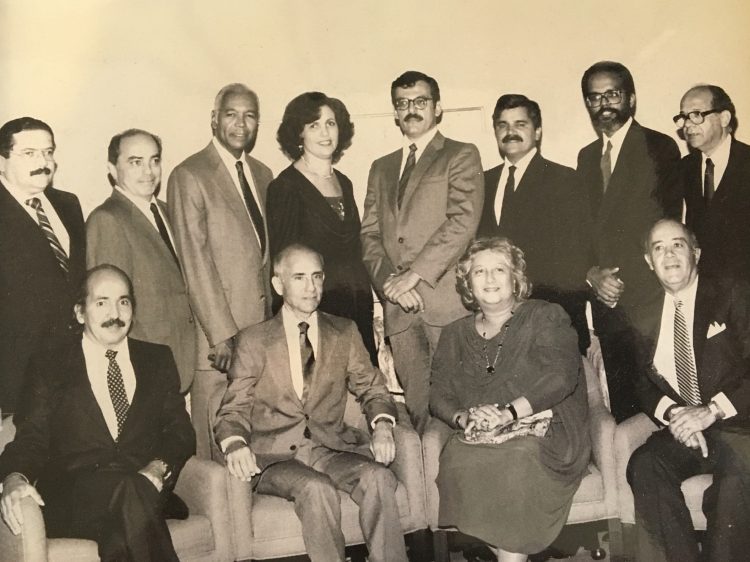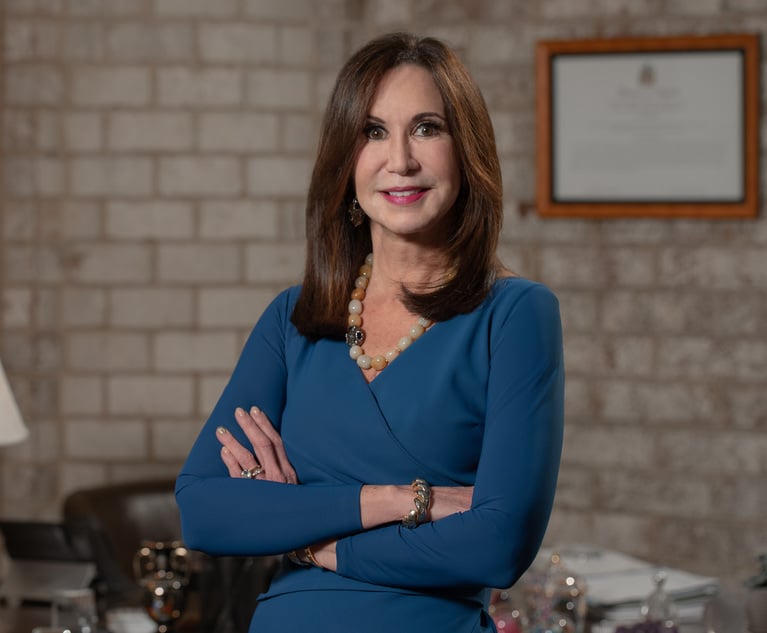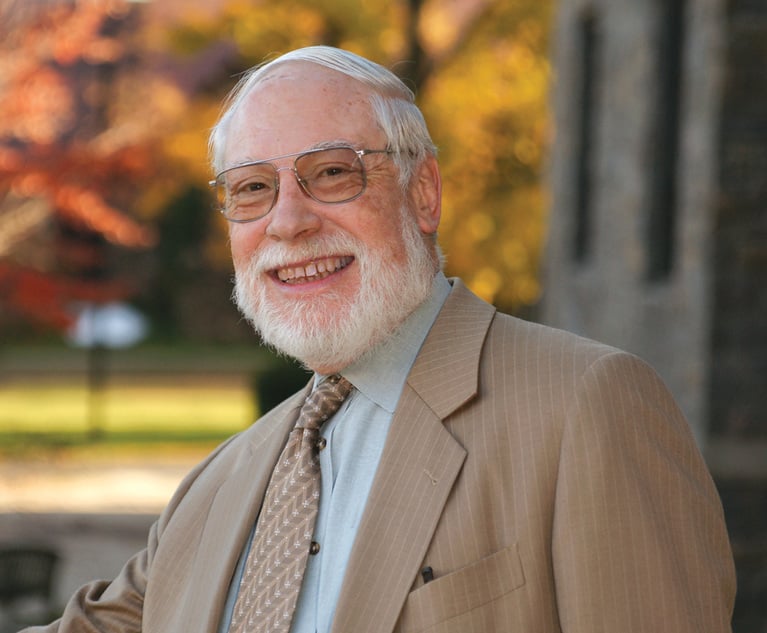Judge Decries Lack of Latino Representation on the Bench
Significantly, this progress occurred without sacrificing superior judicial qualifications at the altar of diversity.
October 03, 2018 at 01:17 PM
8 minute read
 New York State's Latino judges in 1985. Courtesy Photo
New York State's Latino judges in 1985. Courtesy Photo
In celebration of Hispanic Heritage Month, I want to talk about the importance of judicial diversity – in particular, the lack of Latino representation on the bench. I will start with a quote from my great friend Justice Rolando Acosta, the presiding justice of the First Department. The quote is from a “Perspective” column that was published in the New York Law Journal over a decade ago. This is what he said: “The most important goal of [judicial] diversity is [that it would] give credibility to a judicial system that Latinos and people of color have historically viewed with suspicion and distrust. A diverse judiciary [would] engender confidence that courts—the last bastion of justice—have the requisite moral authority to dispense justice to all.” The idea is that our judiciary would be at its best, our judiciary would be viewed as most credible when the community – the users of our courts – begin to see themselves reflected in the judiciary.
Beyond engendering public confidence in the judiciary, however, judicial diversity would also improve the quality of judicial decision making because, according to Sherilyn Ifill, the president of the NAACP Legal Defense and Education Fund, judicial diversity would inject “traditionally excluded perspectives and values into the judicial decision-making [process, and] . . . [c]ourts achieve structural impartiality when judicial decision-making includes a cross-section of perspectives and values from the community.” Federal Judge Denny Chin—now on the Second Circuit—said something similar in 2007 in another “perspective” column in the New York Law Journal. He said: “A broader mix of judges, a bench that more fairly reflects the rich diversity of our society, will improve the overall quality of justice.”
These are not remarkable or ground-breaking propositions. In theory, it is widely accepted now that our judiciary must be diverse and that judges must be selected from a fair cross-section of the community. By way of analogy, the Sixth Amendment right to an impartial jury has been interpreted to include the right to a “representative” jury venire panel precisely so that the jury could be “drawn from a fair cross-section of the community”—which is also known as the right to be tried by a “jury of one's peers,” even though those words are not actually in the Constitution. And, of course, that “fair cross-section” requirement – which I call the diversity requirement in jury selection—is jealously and zealously guarded by the courts. Just consider the Supreme Court's decisions in Batson v Kentucky, 476 US 79 (1986), and its progeny.
Thus, the question is: how are Latinos doing when it comes to judicial diversity in New York State? Does the judiciary reflect a fair cross-section of the community when it comes to Latinos? The answer is NO! I do not want to get too wonky with the numbers but here is the summary: Latinos represent about 20% of the population in New York State, but Latino Judges only represent 7% of the judiciary statewide. In other words, our state judiciary could not be fairly characterized, by any means, as representing a fair cross-section of the community. In fact, according to the American Constitution Society for Law and Policy, an organization which studies judicial diversity in state courts around the country, New York's judiciary is ranked 24th—yes, 24th—in “race and ethnicity representativeness.”
And I did not come here to bash Long Island—really, I love Long Island—but the numbers are way worse in Long Island, where Latinos represent about 18.5% of the population, but Latino judges only represent 2.5% of the judiciary.
As bleak as that all sounds, I do think it is important to recognize that we are making some progress, especially more recently. To illustrate the progress that has been made over the years, let me start by providing you with a little historical perspective of what the Latino Judiciary in New York looked like about 33 years ago. This photo of Latino judges in New York State in 1985 speaks volumes about Hispanic heritage.
Some of these great Latino judges you may recognize: Carmen Beauchamp Ciparick, Luis Gonzalez, John Carro, Jaime Rios, Cesar Quinones, Charles Tejada, Frank Torres,Raul Figueroa, Nicholas Figueroa, Gilbert Ramirez, Irma Vidal Santaella, Donald Grajales and Joseph Torres.
And for the Latino judiciary, it is an important part our Hispanic heritage. This photo, together with my knowledge of current progress, tells a great narrative about how far Latinos have come when it comes to inclusion and diversity within the Judiciary and the legal profession generally. Think about it. In 1985—when I was just starting out as a law student at Columbia University School of Law—the total number of Latino Judges in the great big State of New York could fit in a small room to take a photo. There were only 13 Latino Judges in the whole state—perhaps one or two more who are not reflected in the photo.
Today—33 years later—there are 15 Latino judges in Kings County, 15 Latino Judges in New York County and 28 Latino judges in Bronx County. And there are now approximately 88 Latino Judges statewide. That is progress! Not sufficient progress, but it is progress. And the encouraging fact is that this progress is finally happening outside of New York City—in places like Westchester County, Orange County, Rochester, Buffalo and Albany. And yes, it is even happening on Long Island, with the appointment of Judge Fernando Camacho and the election of Judges Helen Voutsinas, Hector LaSalle, Phil Goglas and more recently Linda Mejias. And, of course, I understand that Judge Voutsinas, the president of the Long Island Hispanic Bar Association, has recently received the county's nomination for Supreme Court. It is very exciting to see this happening.
Notwithstanding the overall lack of sufficient diversity in New York's judiciary, I look at this photo and I see how much we have to celebrate during Hispanic heritage month.
When I argued my first case in the Court of Appeals in 1990, there was not a single Latino judge sitting on that court—and now, after Judge Ciparick retired, we have two, Associate Judge Jenny Rivera and Associate Judge Michael Garcia. And when I argued cases in the Appellate Division in the late 1980s and 1990s, there was only one Latino judge in all four appellate divisions—one Latino Judge (Justice Carro) out of almost 50 appellate judges. Now, of course, there are five Latino Appellate Division justices Reinaldo Rivera, Sallie Manzanet-Daniels, Hector LaSalle and Betsy Barros), including a Latino presiding justice (Rolando Acosta), who, of course, is our second Latino presiding justice in the First Department.
The same was true when I practiced in the trial courts in the 1990s. There were a few Latino Judges in the trial courts but only a few. And now, especially in New York City, our courts, all of them—Family Court, Supreme Court, Civil Court, Housing Court, Surrogate's Court and Criminal Court—are filled with many Latino Judges, some of whom are also serving as administrative judges and supervising judges. Significantly, this progress occurred without sacrificing superior judicial qualifications at the altar of diversity.
So it is true that progress has been slow, but it has also been very consistent. It is only now—that is, more recently—that Latino attorneys, to some extent, are finally able to see themselves reflected in the Judges before whom they appear. And it is important to recognize that both Governor Andrew Cuomo and Chief Judge Janet DiFiore deserve credit for this more recent progress, especially when it comes to the Court of Appeals and Appellate Division appointments, including the First Department presiding justice appointment and the administrative judge and supervisory judge appointments, respectively.
This photo reminds me that we are the lucky beneficiaries of the collective sacrifice of many people, including those African-American and Latino pioneers who laid the foundation for much of our progress regarding judicial diversity today. These 13 judges paved a path for us; they were trailblazers and they broke barriers for all Latinos.
And on a personal level, I feel that they paved a path for me—a Puerto Rican kid who grew up in Manhattan's Frederick Douglas Housing Projects.
And today, during Hispanic heritage month, I am proud to recognize that I stand on the shoulders of my predecessors who struggled so hard over the years for a diverse bar and a diverse judiciary. And I strive every day to pave a path for others so that this progress may continue for generations to come.
In 1985, these 13 judges founded the Association of Judges of Hispanic Heritage, which is now known as the Latino Judges Association.
Joseph A. Zayas is the administrative judge of the Supreme Court (criminal term). He gave this address at the annual gala of the Long Island Hispanic Bar Association, in commemoration of Hispanic Heritage Month.
This content has been archived. It is available through our partners, LexisNexis® and Bloomberg Law.
To view this content, please continue to their sites.
Not a Lexis Subscriber?
Subscribe Now
Not a Bloomberg Law Subscriber?
Subscribe Now
NOT FOR REPRINT
© 2025 ALM Global, LLC, All Rights Reserved. Request academic re-use from www.copyright.com. All other uses, submit a request to [email protected]. For more information visit Asset & Logo Licensing.
You Might Like
View All

A Time for Action: Attorneys Must Answer MLK's Call to Defend Bar Associations and Stand for DEI Initiatives in 2025
5 minute read
The Public Is Best Served by an Ethics Commission That Is Not Dominated by the People It Oversees
4 minute readTrending Stories
- 1Librarian's Termination Violated First Amendment Protections, Lawsuit Claims
- 2Choice-of-Law Issues as the UCC 2022 Amendments Come into Effect
- 3Six Benefits of Taking an Opposing Medical Expert’s Deposition
- 4Ex-Prosecutor’s Trial Ends as Judge Throws Out Her Felony Indictment in Ahmaud Arbery Death Case
- 5Conversation Catalyst: Transforming Professional Advancement Through Strategic Dialogue
Who Got The Work
J. Brugh Lower of Gibbons has entered an appearance for industrial equipment supplier Devco Corporation in a pending trademark infringement lawsuit. The suit, accusing the defendant of selling knock-off Graco products, was filed Dec. 18 in New Jersey District Court by Rivkin Radler on behalf of Graco Inc. and Graco Minnesota. The case, assigned to U.S. District Judge Zahid N. Quraishi, is 3:24-cv-11294, Graco Inc. et al v. Devco Corporation.
Who Got The Work
Rebecca Maller-Stein and Kent A. Yalowitz of Arnold & Porter Kaye Scholer have entered their appearances for Hanaco Venture Capital and its executives, Lior Prosor and David Frankel, in a pending securities lawsuit. The action, filed on Dec. 24 in New York Southern District Court by Zell, Aron & Co. on behalf of Goldeneye Advisors, accuses the defendants of negligently and fraudulently managing the plaintiff's $1 million investment. The case, assigned to U.S. District Judge Vernon S. Broderick, is 1:24-cv-09918, Goldeneye Advisors, LLC v. Hanaco Venture Capital, Ltd. et al.
Who Got The Work
Attorneys from A&O Shearman has stepped in as defense counsel for Toronto-Dominion Bank and other defendants in a pending securities class action. The suit, filed Dec. 11 in New York Southern District Court by Bleichmar Fonti & Auld, accuses the defendants of concealing the bank's 'pervasive' deficiencies in regards to its compliance with the Bank Secrecy Act and the quality of its anti-money laundering controls. The case, assigned to U.S. District Judge Arun Subramanian, is 1:24-cv-09445, Gonzalez v. The Toronto-Dominion Bank et al.
Who Got The Work
Crown Castle International, a Pennsylvania company providing shared communications infrastructure, has turned to Luke D. Wolf of Gordon Rees Scully Mansukhani to fend off a pending breach-of-contract lawsuit. The court action, filed Nov. 25 in Michigan Eastern District Court by Hooper Hathaway PC on behalf of The Town Residences LLC, accuses Crown Castle of failing to transfer approximately $30,000 in utility payments from T-Mobile in breach of a roof-top lease and assignment agreement. The case, assigned to U.S. District Judge Susan K. Declercq, is 2:24-cv-13131, The Town Residences LLC v. T-Mobile US, Inc. et al.
Who Got The Work
Wilfred P. Coronato and Daniel M. Schwartz of McCarter & English have stepped in as defense counsel to Electrolux Home Products Inc. in a pending product liability lawsuit. The court action, filed Nov. 26 in New York Eastern District Court by Poulos Lopiccolo PC and Nagel Rice LLP on behalf of David Stern, alleges that the defendant's refrigerators’ drawers and shelving repeatedly break and fall apart within months after purchase. The case, assigned to U.S. District Judge Joan M. Azrack, is 2:24-cv-08204, Stern v. Electrolux Home Products, Inc.
Featured Firms
Law Offices of Gary Martin Hays & Associates, P.C.
(470) 294-1674
Law Offices of Mark E. Salomone
(857) 444-6468
Smith & Hassler
(713) 739-1250







